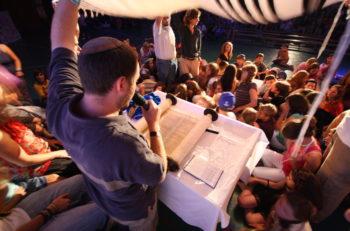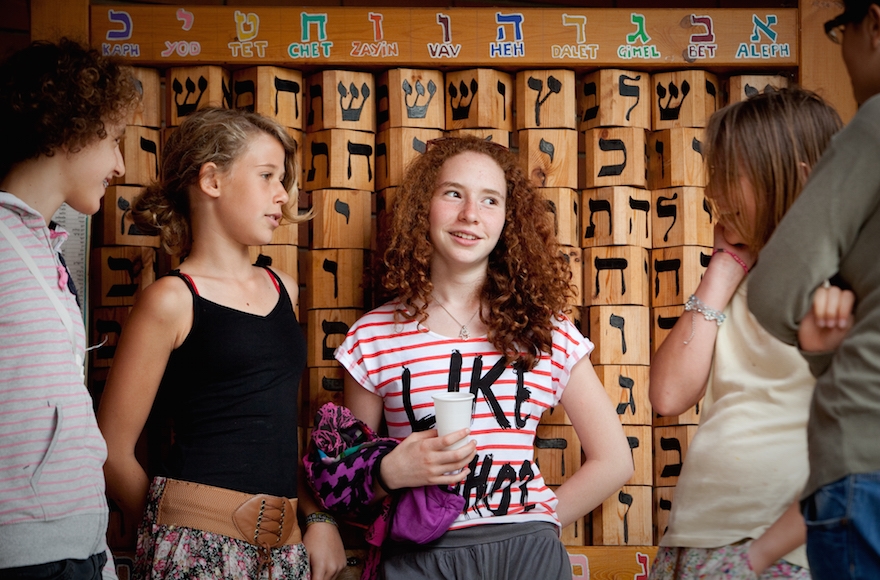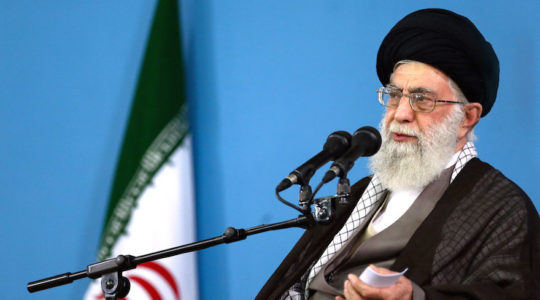SZARVAS, Hungary (JTA) — Escaping a sudden downpour in the summer of 2012, Andras Paszternak and Barbi Szendy ran to find cover inside an empty cabin at their Jewish summer camp, Szarvas, 100 miles east of Budapest.
The two senior counselors, then 31 and 36, respectively, chatted as rain drenched the sprawling compound, where they had passed every summer since their early teens.
“I suddenly noticed I was holding Barbi’s hand,” Paszternak, an ethnically Hungarian Jew from Slovakia, said in recalling the day when he began his romantic relationship with his Hungarian Jewish wife.
The couple married in 2013 at Szarvas — the oldest and largest institution of its kind in Central and Eastern Europe — as a tribute to the camp’s centrality to their lives.
Since its establishment in 1990 by the American Jewish Joint Distribution Committee in co-operation with the Ronald S. Lauder Foundation, dozens — if not hundreds — of Jewish couples have met at Szarvas, according to participants. In addition to its matchmaking capacity, the camp is also a major regional hatchery for Jewish leadership, awareness and global interaction for communities small and large.
WATCH: A Jewish-themed bar becomes a magnet for young Jews in Budapest
“We generally stay out of the boy-meets-girl part of things because our help is not required in this department,” said Sasha Friedman, the camp’s director. “It happens on its own, on the margins of our core activities — which is to offer Jewish culture to these children, often for the first time in their lives.”
JDC opened Szarvas in 1990 on a 17-acre plot in Bekes County, a rural area in southeastern Hungary known for its springs and sunflower fields. The camp began by serving groups of 200 children and has grown to its current capacity of 1,700 Jewish campers aged 8-18. Szarvas has over 20,000 alumni from more than 30 countries.
Some of the couples who met at Szarvas immigrated to Israel. They include Anna and Naftali (Grego) Deutsch from Hungary, who got together as counselors and are now raising seven children in the West Bank settlement of Mitzpe Yericho, where they moved in 2005. Others, like Gabor and Tunde Gordon, who met as campers and married in 1996, stayed in Hungary. Four of their five children are attending the camp.
Szarvas now has four annual sessions, each 12 days long. Every Szarvas summer has a different theme — last year’s was “relationships in Judaism,” this year’s is “the Jewish home” – with its own unique activities, including the production of plays and song contests. That’s in addition to the regular repertoire of sports, costume parties, Hebrew-language games and Bible-themed treasure hunts.
Spiritual life at the camp, which has a kosher kitchen and dozens of non-Jewish employees, revolves around Beit David — a synagogue that since its construction in 1998 is Hungary’s newest functioning shul. On Friday nights it is packed with children and teenagers, some visiting a synagogue for the first time. Many are amazed to see resident rabbi Szolt Balla — himself a Szarvas graduate — play guitar during singalongs, an uncommon sight in Europe, where Orthodox synagogues dominate religious life.

Shabbat services and Jewish life are integral parts of the Szarvas experience. (Courtesy of the American Jewish Joint Distribution Committee)
Most campers, who are usually at least one-quarter Jewish, pay $250 or less for their attendance at Szarvas — 25 percent of the true cost — with JDC subsidizing the rest.
But for Szarvas teenagers, the official program is only part of the allure.
Summer romance at Szarvas occurs in the camp’s orchards, where the silhouettes of young couples can be seen until late in the evening, or on the edges of the camp’s large swimming pool — a luxury built by an Israeli firm back when such amenities were rare in post-communist Hungary.
“Yeah, it’s part of life here,” Friedman said. While boys and girls sleep separately at Szarvas, counselors have a live-and-let-live policy when it comes to summer romance, he said.
“Counselors keep an eye out for potential complications, sometimes reminding couples to act responsibly and not spin out of control or anything, but that’s pretty much it,” the camp director added.
In addition to couples, Szarvas specializes in producing Jewish community leaders. Among its graduates are a former vice president of the Jewish Community of Sofia in Bulgaria, the director of Warsaw’s main Jewish community center and a founder of one of Romania’s few Jewish kindergartens.
“You take the knowledge, the contacts, the toolbox that you get at Szarvas and you apply them later inside the community,” said Szendy, who works at Budapest’s Balint Jewish Community Center.
Friedman, 33, is himself a Szarvas graduate who rose through the ranks to become director in 2007. He calls Szarvas a “greenhouse for Jewish leadership.” But before he has a chance to explain, he is interrupted by a gaggle of Hungarian 8-year-olds who surround him, chirping “Shushi” — their nickname for him – so they can tell him about their daily adventures.
READ: Jewish summer camp in Ukraine relocated due to war
Last year, JDC incorporated Szarvas into its array of solutions for handling the humanitarian crisis in Ukraine, where hundreds of thousands of people, including thousands of Jews, fled their homes because of fighting that erupted in 2014 between government troops and Eastern separatists backed by Russia.
Additionally, of the approximately 120 Ukrainian campers in attendance last summer, 26 were from internally displaced families living with relatives or in facilities provided by Jewish institutions.
“In these harsh times, we prioritized these children because they need a sense of belonging and warmth now more than ever,” said Michal Frank, JDC’s director for former Soviet countries.
At Szarvas, participants largely remain with members of their own country delegation, with whom they sleep, dine and undergo activities. But each nation group is paired with another group during daily “mifgashim” (Hebrew for “encounters”) sessions, when they get a taste of what Judaism means in the other country.
On a continent with many small, isolated Jewish communities with high intermarriage rates, the international dimension at Szarvas means that for some campers, Szarvas is their best bet for finding a Jewish partner, according to Paszternak, who grew up in a town with 30,000 residents and a Jewish community of just a few dozen people.
“No one enrolled me into Szarvas as a boy of 10 thinking I’d find a Jewish wife there,” he said. But, in retrospect, “for Jews from small communities especially, it’s often the only game in town where this sort of thing happens.”
(JTA’s special section on camps, made possible with funding from the Foundation for Jewish Camp, examines trends affecting Jewish overnight camps.)
JTA has documented Jewish history in real-time for over a century. Keep our journalism strong by joining us in supporting independent, award-winning reporting.






